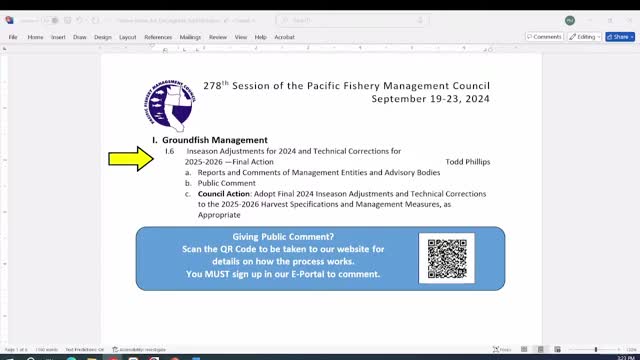California fisheries adapt to new regulations amid rockfish crisis
September 21, 2024 | Fishery Management Council, Pacific, Governor's Office - Boards & Commissions, Executive, Washington
This article was created by AI summarizing key points discussed. AI makes mistakes, so for full details and context, please refer to the video of the full meeting. Please report any errors so we can fix them. Report an error »

In a recent government meeting, officials discussed significant changes to California's recreational fishing season and non-trawl commercial fishery regulations, primarily driven by the need to address extremely low allowable mortality rates for quillback rockfish. The adjustments, which took effect in late 2023 and will continue into 2024, have notably altered the dynamics of California's non-trawl fisheries.
For the upcoming year, the harvest guideline for yelloweye rockfish is set at 11.8 metric tons, with an anticipated catch target (ACT) of 9.3 metric tons. Current estimates indicate that the catch through early September is well within these limits, suggesting effective management practices are in place. Similarly, quillback rockfish remains classified within a minor nearshore rockfish complex, with projections indicating compliance with area-specific ACT values.
The meeting highlighted a positive trend in angler compliance with non-retention requirements for quillback rockfish, with reports showing that 90-96% of encountered fish are being released. This compliance, combined with new regulations requiring anglers to use descending devices, has led to lower discard mortality rates compared to previous years.
In terms of commercial fishing, there have been no reported landings of quillback rockfish since the prohibition was enacted in August 2023. The discard mortality for quillback in the open access sector has significantly decreased from 6.9 metric tons in 2022 to just 1.3 metric tons in 2023, indicating that management measures are effectively reducing catch levels.
The meeting also addressed the status of other rockfish species, including copper and vermilion rockfish. While the recreational fishery has reported lower catches this year, the commercial sector has also seen a decline, suggesting that recent restrictions on trip and bag limits are having the desired effect of reducing overall harvest.
Looking ahead, officials are optimistic that the management strategies implemented will keep mortality rates within acceptable limits, ensuring the sustainability of California's fisheries. The meeting concluded with an acknowledgment of the hard work put in by the California Department of Fish and Wildlife (CDFW) staff in compiling these reports, which provide crucial insights into the health of the state's fishery resources.
For the upcoming year, the harvest guideline for yelloweye rockfish is set at 11.8 metric tons, with an anticipated catch target (ACT) of 9.3 metric tons. Current estimates indicate that the catch through early September is well within these limits, suggesting effective management practices are in place. Similarly, quillback rockfish remains classified within a minor nearshore rockfish complex, with projections indicating compliance with area-specific ACT values.
The meeting highlighted a positive trend in angler compliance with non-retention requirements for quillback rockfish, with reports showing that 90-96% of encountered fish are being released. This compliance, combined with new regulations requiring anglers to use descending devices, has led to lower discard mortality rates compared to previous years.
In terms of commercial fishing, there have been no reported landings of quillback rockfish since the prohibition was enacted in August 2023. The discard mortality for quillback in the open access sector has significantly decreased from 6.9 metric tons in 2022 to just 1.3 metric tons in 2023, indicating that management measures are effectively reducing catch levels.
The meeting also addressed the status of other rockfish species, including copper and vermilion rockfish. While the recreational fishery has reported lower catches this year, the commercial sector has also seen a decline, suggesting that recent restrictions on trip and bag limits are having the desired effect of reducing overall harvest.
Looking ahead, officials are optimistic that the management strategies implemented will keep mortality rates within acceptable limits, ensuring the sustainability of California's fisheries. The meeting concluded with an acknowledgment of the hard work put in by the California Department of Fish and Wildlife (CDFW) staff in compiling these reports, which provide crucial insights into the health of the state's fishery resources.
View full meeting
This article is based on a recent meeting—watch the full video and explore the complete transcript for deeper insights into the discussion.
View full meeting
